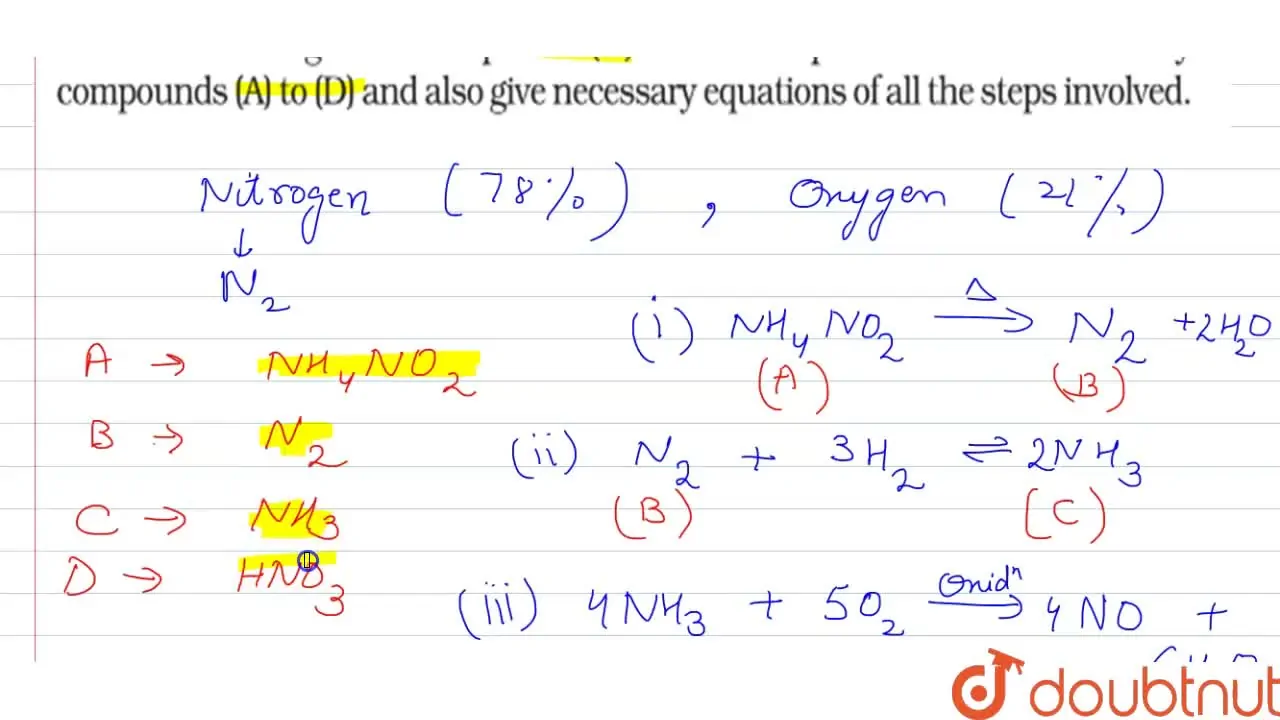On heating compound (A) gives a gas (B) which is a constituent of air.
This gas when treted with 3 moles of hydrogen (H2) in the presence of a catalyat gives another gas (C ) which is basic in nature. Gas C on further oxidation in moist condition gives a compound (D) which is a part of acid rain. Identify compounds (A) to (D) and also give necessary equations of all the steps involved .
(i) Since gas 'B' on heating with 3 moles of hydrogen in presence of a catalyst, gives a gas 'C' which is basic in nature, therefore, 'C' must be ammonia (NH3) and gas (B) must be N2
N2(B)+3H2Δ,Catalyst−−−−−−→2NH3Ammonia (C)
(ii) Since gas 'B' (i.e., N2) is obtained by heating compound (A), therefore, compound (A) must be either ammonium nitrite or ammonium dichromate
NH4(A)NO2Δ−−→N2(B)+2H2Oor(NH4)2(A)Cr2O7Δ−−→N2(B)+Cr2O3+4H2O
(iii) Since gas 'C', (i.e., NH3) on further oxidation in moist conditions gives compound (D) which is a part of acid rain, therefore, compound (D) must be nitric acid (HNO3).
4NH3(C)+5O2Oxidation−−−−−→4NO+6H2O2NO+O2→2NO2 , 3NO2+H2O→2HNO3(D)+NO
Thus, A=NH4NO2or(NH4)2Cr2O7,B=N2,C=NH3andD=HNO3.
Related Playlists
- BOOK - PRADEEPCHAPTER - P-BLOCK ELEMENTS EXERCISE - VERY SHORT ANSWER QUESTIONS108videos
P-BLOCK ELEMENTS
- BOOK - PRADEEPCHAPTER - P-BLOCK ELEMENTS EXERCISE - HOTS QUESTIONS9videos
P-BLOCK ELEMENTS
- BOOK - PRADEEPCHAPTER - P-BLOCK ELEMENTS EXERCISE - ASSERTION AND REASON TYPE QUESTIONS6videos
P-BLOCK ELEMENTS
- BOOK - PRADEEPCHAPTER - ORGANIC COMPOUNDS CONTAINING NITROGENEXERCISE - IMPORTANT QUESTIONS FOR BOARD EXAMINATION27videos
ORGANIC COMPOUNDS CONTAINING NITROGEN
- BOOK - PRADEEPCHAPTER - POLYMERSEXERCISE - IMPORTANT Questions (For Board Examination)27videos
POLYMERS
Similar Questions
On heating compound (A) gives a gas (B) which is a constituent of air.
This gas when treted with 3 moles of hydrogen (H2) in the presence of a catalyat gives another gas (C ) which is basic in nature. Gas C on further oxidation in moist condition gives a compound (D) which is a part of acid rain. Identify compounds (A) to (D) and also give necessary equations of all the steps involved .View SolutionOn heating compound (A) gives a gas (B) which is a constituent of air. This gas when treated with 3 mol of hydrogen (H2) in the presence of a catalyst gives another gas (C) which is basic in nature. Gas C on further oxidation in moist condition gives a compound (D) which is a part of acid rain. Identify compounds (A) to (D) and also give necessary equations of all the steps involved.
View SolutionOn heating compound (A) gives a gas (B) which is a constituent of air.
This gas when treted with 3 moles of hydrogen (H2) in the presence of a catalyat gives another gas (C ) which is basic in nature. Gas C on further oxidation in moist condition gives a compound (D) which is a part of acid rain. Identify compounds (A) to (D) and also give necessary equations of all the steps involved .View SolutionOn heating compound (A) gives a gas (B) which is a constituent of air . This gas when treated H2 in the presence of a catalyst gives another gas (C) which is basic in nature. (A) should not be :
View SolutionCalcium imide on hydrolysis will give gas (B) which on oxidation by beaching powder gives gas (C) gas (C) on reaction with magnesium give compound (D). (D) on hydrolysis gives gas (B). (B),(C) and (D) are
View SolutionA non-metal A which is the largest constituent of air, when heated with H2 in 1 : 3 ratio in the presence of catalyst (Fe) gives a gas B. 0n heating with O2 it gives an oxide C. If this oxide is passed into water in the presence of air, it gives an acid D which acts as a strong oxidising agent.
(a) Identify A, B, C and D.
(b) To which group of the periodic table does this non-metal belongs?View SolutionA compound (A) of boron reacts with Nme3 to give an adduct (B) which on hydrolysis gives a compound (C) and hydrogen gas. Compound (C) is an acid. Identify the compounds A,B and C. give the reactions inovolved.
View SolutionCalcium imide on hydrolysis will give gas (B) which on oxidation by beaching powder gives gas (C) gas (C) on reaction with magnesium give compound (D). (D) on hydrolysis gives gas (B). (B),(C) and (D) are
View SolutionA compound (A) of boron reacts with Nme3 to give an adduct (B) which on hydrolysis gives a compound (C) and hydrogen gas. Compound (C) is an acid. Identify the compounds A,B and C. give the reactions inovolved.
View SolutionA black mineral (A) on heating in presence of air gives a gas (B). The mineral (A) on reaction with dilute H2SO4 gives a gas (C) and a solution of a compound (D) on passing the gas (C) into an aqueous solution of (B), a white turbidity is obtained. The aqueous solution of (D) on reaction with potassium ferricyanide gives a blue compound (E). Identify (A) to (E) and give chemical equations for the reaction involved.
View Solution


